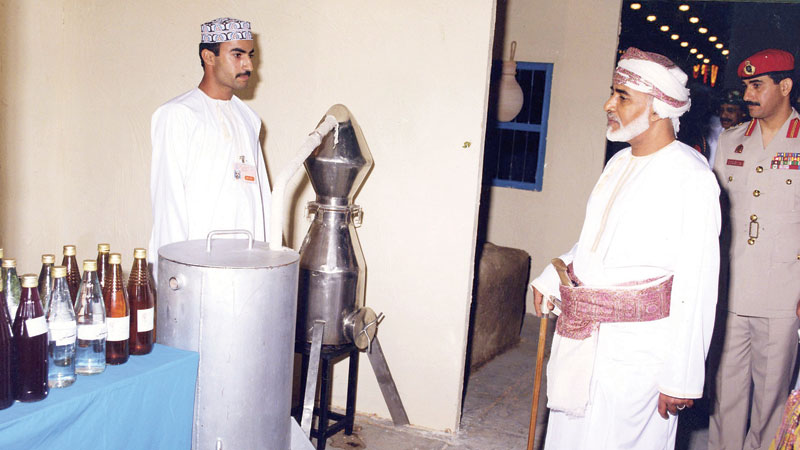

This is why we are determined to promote the role of our people in the agricultural, fisheries and the livestock industries. Their effective participation in our development march reflects the traditions and genius of our Omani race: His Majesty Sultan Qaboos
Amid bids to build a more diversified economy, the country is still looking to its agricultural roots as desired by His Majesty Sultan Qaboos. Once central to its economy, the agriculture sector fell by the wayside after the discovery of oil in the mid-20th century. But it is still a major source of revenue to the national economy and employment. A combination of food security concerns and a focus on economic diversification have made agriculture and fisheries an area of priority government investment in recent years. Agricultural self-sufficiency, as desired by the late Sultan, continues to grow in the Sultanate.
His Majesty declared 1988 as the “Year of Agriculture” to encourage this vital sector. “It is our aim, in announcing this year as the Year of Agriculture, to achieve a broadcasting of our country’s development by focusing on the exploitation of our rich land resources and the inherited traditional abilities of our people. This will continue to require intensive work by all. It will also require the maintenance of a serious and responsible spirit towards the task”, he said during his 18th National Day speech.
Oman is endowed with its rich biodiversity as it has not only diversified traditional agriculture involving almost all types of crop species but also vast rangelands especially in Dhofar having various pasture species. It has wide diversity of crop plants for food and fodder.
Oman is well aware of the importance of its own plant genetic resources, and hence, attained the status of a constituent member to actively involve in the Global Plan of Action for food and agriculture through the Royal Decree 10/97 in 1997.
Realising that there was further requirement to focus on the exploitation of the country’s rich land resources and the “traditional abilities of its people”, the late Sultan declared 1989 as also the Year of Agriculture”.
“We have followed with appreciation the distinguished work already done by both our government and citizens during this year in furthering the development of agriculture, but we cannot be satisfied. It must be regarded as the beginning of an intense and sustained effort to develop this field to the maximum. Hence we declare today the continuance of this campaign of the Year of Agriculture into next year”, he said.
Through different campaigns, the government encouraged private-sector investment by allocating generous amounts of cash support for the private sector to be disbursed mainly through banks. The Oman Bank for Agriculture and Fisheries, created in 1981, extended loans at subsidy rates to individuals for whom farming or fishing is the principal activity.
The bank acts as a distributive institution, receiving an interest subsidy from the government. In 1990 there were 1,308 loans, totalling RO4.7 million.
In the early 1990s, interior farming areas accounted for more than one-half of the country’s cultivated land. Rainfall, although greater in the interior than along the coast, is insufficient for growing crops. Most of the water for irrigation is from the falaj system, in which a vertical shaft is dug from the surface to reach water in porous rock.
As more water was required to irrigate the farms, His Majesty Sultan Qaboos called for efforts for prudent water conservation. In this regard, he stressed on the need for additional dams, maintenance of the aflaj and wells, and the role of Agricultural Guidance Centers in the service of farmers.
“We have given our directives to our government to support the agricultural development programme by the construction of additional dams, maintenance of the aflaj and wells, and promotion of the role of Agricultural Guidance Centres in the service of the farmers”, he said.
Thanks to the steps initiated by the late His Majesty, the government encourages farming by distributing land, offering subsidised loans to purchase machinery, offering free feedstock, and giving advice on modern irrigation methods.
As a result, the area under cultivation has increased, with an accompanying rise in production. But extensive agricultural activity has also depleted freshwater reserves and underground aquifers and has increased salinity.
Today, the main crops grown in Oman include dates, bananas, and coconuts, all of which have a centuries-long history of production in Oman. Dates, for example, are Oman’s largest crop, with half of all agricultural land devoted to date farming, and the country is the eighth-largest producer of the sticky treat in the world.
According to official statistics, the Sultanate’s food production has increased from 3.2 million tonnes in 2017 to 3.8 million tonnes in 2018, achieving an unprecedented growth rate of 17.2 per cent, while the value of local food production has increased from 44 per cent to 50 per cent between 2015 and 2018, respectively.
The self-sufficiency ratios of most of the food commodities produced in the Sultanate has increased to 79 per cent of the total produced and imported food products, including fish, dates, vegetables, fruit, milk, red meat, poultry meat, eggs and honey. The Sultanate is ranked third in Gulf and Arab countries and the twenty-eighth globally in self-sufficiency of food in 2018.
Oman Observer is now on the WhatsApp channel. Click here



